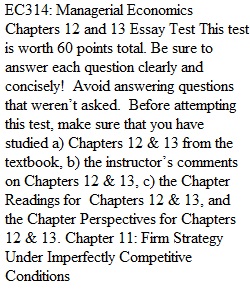


Q EC314: Managerial Economics Chapters 12 and 13 Essay Test This test is worth 60 points total. Be sure to answer each question clearly and concisely! Avoid answering questions that weren’t asked. Before attempting this test, make sure that you have studied a) Chapters 12 & 13 from the textbook, b) the instructor’s comments on Chapters 12 & 13, c) the Chapter Readings for Chapters 12 & 13, and the Chapter Perspectives for Chapters 12 & 13. Chapter 11: Firm Strategy Under Imperfectly Competitive Conditions A. Briefly explain what the two new market structures introduced in this chapter –monopolistic competition and oligopoly – add to our analysis that wasn’t there before (in other words, why bother with them?) (6 points) B. Famous TV news commentator: “Corporate raiders” embody all that is wrong with the capitalist system. These people are only in it for the money. They don’t care about the firm’s customers, or the firm’s workers, or the other owners. They just want to make a buck in the short-run, even if they leave things in ruins after they have done their worst.” 1. Explain why this person needs to take a course in Managerial Economics. 2. That said, does that mean that a firm should never mount a defense against a hostile takeover? (16 points) C. “This company is so unfair! They obviously don’t care about their customers. They __________!” complains Cindy Consumer. (the blank could be filled in with statements like: “They won’t discount their product like that other company,” or “(a hotel) charge a much higher price than other hotels in the area,” or “they used to take returns no questions asked, but now they have lots of restrictions.”) Explain to Cindy why economists think her complaints are naïve. (Why firms mistreating their customers may actually be in their customers’ best interest!) (8 points) Chapter 12: Competitive and Monopsonistic Labor Markets A. Piece-rate pay coexists in our economy with hourly wage pay. (16 points) 1. Why is that? What aspects of a business (or job) would lead you to expect that it would be characterized by one or the other? 2. Studies suggest that, comparing workers who do similar jobs, those who are paid by piece-rate earn more than those who are paid straight wages. What reasons does the text suggest for this difference? B. I remember when women used to wear buttons that said 59 cents on them, indicating that the average woman earned only 59 cents for every dollar earned by a man. The number has gone up (and the gap continues to shrink), but the average woman who works still earns less than the average man. Many people, including many in the media, infer from this that discrimination against women is a serious problem in the labor market. But, before economists conclude that there is discrimination going on, they seek other explanations for such pay differences. What forces (affecting the demand for and supply of labor) would help explain such a difference in terms other than discrimination? (8 points) C. According to the textbook, why is it that professors in academics get tenure while most people in business (except for partners in law or accounting firms) do not? (Your answer should emphasize something different in terms of the nature of the work jobs.) (6 points)
View Related Questions